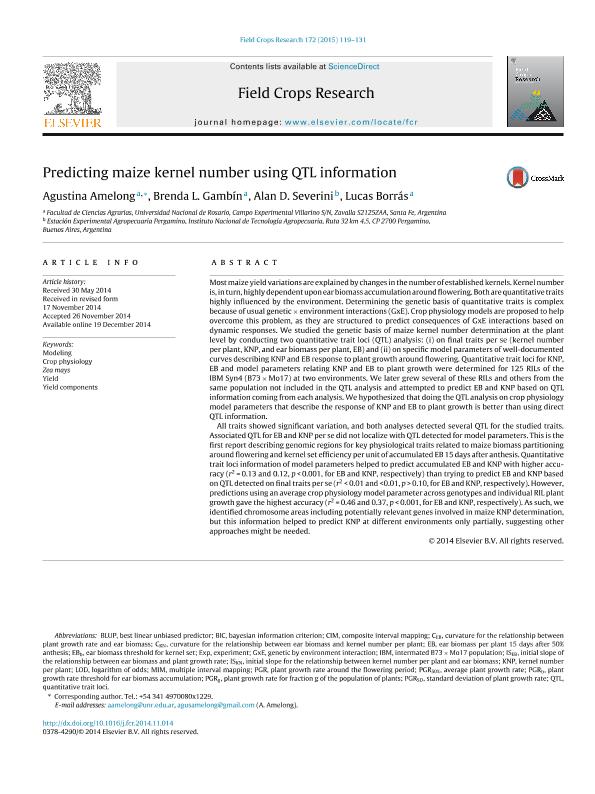Mostrar el registro sencillo del ítem
dc.contributor.author
Amelong, Agustina

dc.contributor.author
Gambin, Brenda Laura

dc.contributor.author
Severini, Alan David

dc.contributor.author
Borras, Lucas

dc.date.available
2018-06-25T18:54:36Z
dc.date.issued
2015-02
dc.identifier.citation
Amelong, Agustina; Gambin, Brenda Laura; Severini, Alan David; Borras, Lucas; Predicting maize kernel number using QTL information; Elsevier Science; Field Crops Research; 172; 2-2015; 119-131
dc.identifier.issn
0378-4290
dc.identifier.uri
http://hdl.handle.net/11336/49972
dc.description.abstract
Most maize yield variations are explained by changes in the number of established kernels. Kernel number is, in turn, highly dependent upon ear biomass accumulation around flowering. Both are quantitative traits highly influenced by the environment. Determining the genetic basis of quantitative traits is complex because of usual genetic. ×. environment interactions (GxE). Crop physiology models are proposed to help overcome this problem, as they are structured to predict consequences of GxE interactions based on dynamic responses. We studied the genetic basis of maize kernel number determination at the plant level by conducting two quantitative trait loci (QTL) analysis: (i) on final traits per se (kernel number per plant, KNP, and ear biomass per plant, EB) and (ii) on specific model parameters of well-documented curves describing KNP and EB response to plant growth around flowering. Quantitative trait loci for KNP, EB and model parameters relating KNP and EB to plant growth were determined for 125 RILs of the IBM Syn4 (B73. ×. Mo17) at two environments. We later grew several of these RILs and others from the same population not included in the QTL analysis and attempted to predict EB and KNP based on QTL information coming from each analysis. We hypothesized that doing the QTL analysis on crop physiology model parameters that describe the response of KNP and EB to plant growth is better than using direct QTL information.All traits showed significant variation, and both analyses detected several QTL for the studied traits. Associated QTL for EB and KNP per se did not localize with QTL detected for model parameters. This is the first report describing genomic regions for key physiological traits related to maize biomass partitioning around flowering and kernel set efficiency per unit of accumulated EB 15 days after anthesis. Quantitative trait loci information of model parameters helped to predict accumulated EB and KNP with higher accuracy (r2=0.13 and 0.12, p<0.001, for EB and KNP, respectively) than trying to predict EB and KNP based on QTL detected on final traits per se (r2<0.01 and <0.01, p>0.10, for EB and KNP, respectively). However, predictions using an average crop physiology model parameter across genotypes and individual RIL plant growth gave the highest accuracy (r2=0.46 and 0.37, p<0.001, for EB and KNP, respectively). As such, we identified chromosome areas including potentially relevant genes involved in maize KNP determination, but this information helped to predict KNP at different environments only partially, suggesting other approaches might be needed.
dc.format
application/pdf
dc.language.iso
eng
dc.publisher
Elsevier Science

dc.rights
info:eu-repo/semantics/openAccess
dc.rights.uri
https://creativecommons.org/licenses/by-nc-nd/2.5/ar/
dc.subject
Crop Physiology
dc.subject
Modeling
dc.subject
Yield
dc.subject
Yield Components
dc.subject
Zea Mays
dc.subject.classification
Otras Biotecnología Agropecuaria

dc.subject.classification
Biotecnología Agropecuaria

dc.subject.classification
CIENCIAS AGRÍCOLAS

dc.title
Predicting maize kernel number using QTL information
dc.type
info:eu-repo/semantics/article
dc.type
info:ar-repo/semantics/artículo
dc.type
info:eu-repo/semantics/publishedVersion
dc.date.updated
2018-06-25T12:39:22Z
dc.journal.volume
172
dc.journal.pagination
119-131
dc.journal.pais
Países Bajos

dc.journal.ciudad
Amsterdam
dc.description.fil
Fil: Amelong, Agustina. Universidad Nacional de Rosario. Facultad de Ciencias Agrarias; Argentina. Consejo Nacional de Investigaciones Científicas y Técnicas; Argentina
dc.description.fil
Fil: Gambin, Brenda Laura. Universidad Nacional de Rosario. Facultad de Ciencias Agrarias; Argentina. Consejo Nacional de Investigaciones Científicas y Técnicas; Argentina
dc.description.fil
Fil: Severini, Alan David. Instituto Nacional de Tecnología Agropecuaria. Centro Regional Buenos Aires Norte. Estación Experimental Agropecuaria Pergamino; Argentina
dc.description.fil
Fil: Borras, Lucas. Universidad Nacional de Rosario. Facultad de Ciencias Agrarias; Argentina. Consejo Nacional de Investigaciones Científicas y Técnicas; Argentina
dc.journal.title
Field Crops Research

dc.relation.alternativeid
info:eu-repo/semantics/altIdentifier/doi/http://dx.doi.org/10.1016/j.fcr.2014.11.014
dc.relation.alternativeid
info:eu-repo/semantics/altIdentifier/url/https://www.sciencedirect.com/science/article/pii/S037842901400330X
Archivos asociados
